Flowers in the borders around our lower lawn, August 15, 2014.
To see what’s blooming in other garden bloggers’ gardens, visit Carol at May Dreams Gardens.
Flowers in the borders around our lower lawn, August 15, 2014.
To see what’s blooming in other garden bloggers’ gardens, visit Carol at May Dreams Gardens.
It has been two years since I made a number of significant changes to our Kigali, Rwanda, garden, and I thought this would be a good time to look back with a series of “before and after” pictures.
Today, I’ll focus on the “lower lawn” — the largest part of the garden, which is parallel to and just below the “upper lawn.”
(You can read about the upper lawn’s “before and after” in my July 25 post here).
 Photos above and below: late 2011.
Photos above and below: late 2011.
Then and now, looking down on the lower lawn from the front of the house, you see grass and a clipped bougainvillea hedge along the front of the property — and then the view above.
 This is to the right of the previous photo; that’s Mt. Kigali over the front hedge — seen from the center steps that align with the middle of the house and terrace.
This is to the right of the previous photo; that’s Mt. Kigali over the front hedge — seen from the center steps that align with the middle of the house and terrace.
When you go down the center steps and stand on the lower lawn, the views of the city and hills are hidden and the flower/shrub borders are all you see.
Back in 2011, I thought it was all too straight, too wide (the grass), too dull. And the bright white Victorian lampposts lined up out in the grass drove me crazy.
 There is a slight slope to the lawn, toward the front hedge. Along that hedge (shown above, right) was a very narrow planting strip, into which a variety of nice shrubs were wedged. I always had a feeling that they and the lawn could just slide down under the hedge.
There is a slight slope to the lawn, toward the front hedge. Along that hedge (shown above, right) was a very narrow planting strip, into which a variety of nice shrubs were wedged. I always had a feeling that they and the lawn could just slide down under the hedge.
The practical purpose of the lower lawn area is holding large events. And from that standpoint, it was already working well. The occasional need to put up tents meant that we could not remove a lot of the grass, but, as you can see in the picture just above, there was enough room to create a wider, much more interesting planting bed along the front hedge.
 Above is the same area of the previous photo in the summer of 2012, soon after we started making changes. At this point, we had already painted the lampposts dark brown.
Above is the same area of the previous photo in the summer of 2012, soon after we started making changes. At this point, we had already painted the lampposts dark brown.
All the borders in the garden on the north side of the house (next post) and along the upper and lower lawns were re-cut in irregular curves — echoing the forms of the surrounding hills. The curves also provide a counterpoint to the long straight lines of the parallel lawns, borders, walls, and front hedge.
 Above: the same section in late June 2014.
Above: the same section in late June 2014.
While I couldn’t remove a lot of grass in the center section of the lawn, the curvy borders can swing out a bit at the north and south ends.
 Above: the full lower lawn, looking from the north.
Above: the full lower lawn, looking from the north.
 Above: standing on the upper lawn, looking across to the front border in April 2014.
Above: standing on the upper lawn, looking across to the front border in April 2014.
 Above: standing at the center steps, looking across — this is the same view as in the second photo in this post, above.
Above: standing at the center steps, looking across — this is the same view as in the second photo in this post, above.
 Above: the full lower lawn, looking from the south.
Above: the full lower lawn, looking from the south.
 Above: in late 2011, on the house side of the lawn, the old 9′ heliconias in the border between the two retaining walls loomed down. . .
Above: in late 2011, on the house side of the lawn, the old 9′ heliconias in the border between the two retaining walls loomed down. . .
 . . . and were pretty tattered; I think we had had a hail storm not long before I took the photo above.
. . . and were pretty tattered; I think we had had a hail storm not long before I took the photo above.
 Above: the same section, in late June 2014.
Above: the same section, in late June 2014.
 Above: the grass-level planting bed was extended out to contain the lampposts.
Above: the grass-level planting bed was extended out to contain the lampposts.
 Above: from the center of the lawn, looking at the south side of the retaining walls.
Above: from the center of the lawn, looking at the south side of the retaining walls.
The borders along the upper lawn in our Kigali garden are blooming particularly well this month. I took these pictures yesterday.
(You can control the slideshow by hovering the cursor over it. Or you can scroll through larger versions of the photos by clicking on ‘Continue reading’ below and then on any thumbnail in the gallery.)
Our front garden is a rather formal arrangement of two long lawns that run parallel to each other and to the length of the house and its terrace. The narrow upper one is separated from the much wider lower one by two sets of 3′ retaining walls, which are joined in the center by a flight of steps. Irregularly curving planting beds border both sides of the lower lawn and one side of the upper.
I’ve tried to balance the formal layout with an informal, sort of “country garden” planting plan. The beds contain a closely planted mix of tropical and temperate plants and shrubs. Most are cultivated, but the “wild” plants and vines that work their self-seeding way up through the jumble can stay if they they add nice textures or colors.
The beds between the retaining walls and the one along the far side of the lower lawn are anchored by several large, often flowering, shrubs and lianas, and even some small trees.
Because of the vigorous plants and the constant warm weather, I’m always pruning or chopping something back.
Almost every plant repeats in the garden, often in several places. But each 7′ to 15′ section of border has its own primary and secondary colors and then a bit of a third color trailing through the middle or around the edges.
The border along the upper lawn starts out orange and white (with a little pink) at its south end, then becomes yellow and blue/purple with some orange to the center steps. On the north side of the steps, it is yellow and blue/purple again with a stronger trail of orange (red hot poker, lantana, tropical hibiscus). At the north end, it is red and pink with blue around the edges.
Garden Bloggers’ Bloom Day is the 15th of every month. To see what’s blooming today in other bloggers’ gardens, visit Carol at May Dreams Gardens.
My earlier March Bloom Day post today is here.
Continue reading “More Bloom Day in March”
It has rained almost every day this month, and everything in the garden has been growing accordingly. Here’s a little tour — from some photos I’ve taken in the last few days.
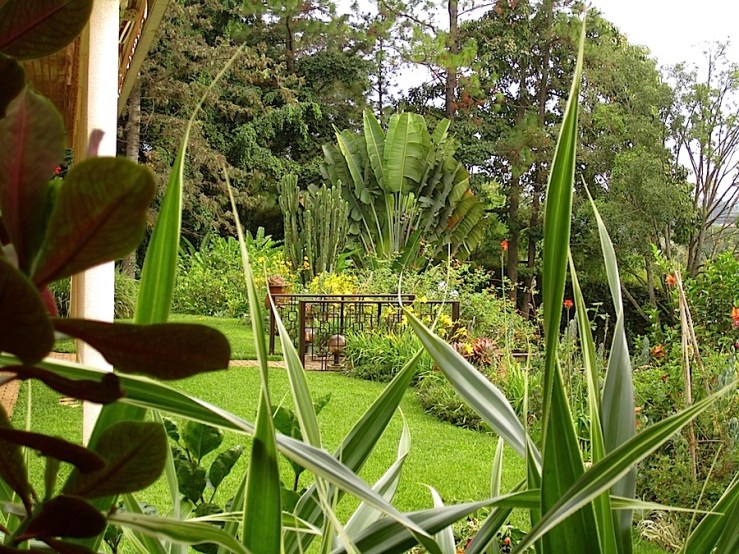 Above: Looking across the upper lawn from the north side. The front terrace of the house is to the left.
Above: Looking across the upper lawn from the north side. The front terrace of the house is to the left.
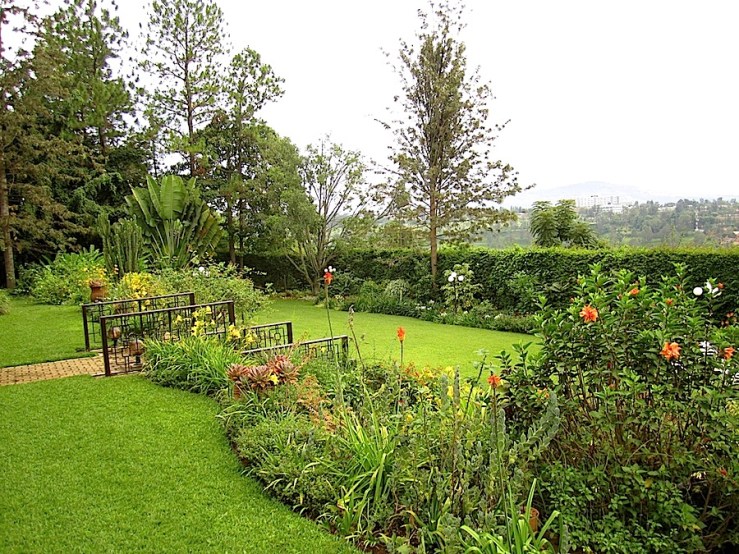 Above: Looking across the upper lawn and the planting beds of the two retaining walls. In the narrow border at the top, there are yellow daylilies, the bright blue-flowering (in the morning) groundcover evolvulus, and orange Kniphofia uvaria (red hot pokers). At the right is an orange tropical hibicus.
Above: Looking across the upper lawn and the planting beds of the two retaining walls. In the narrow border at the top, there are yellow daylilies, the bright blue-flowering (in the morning) groundcover evolvulus, and orange Kniphofia uvaria (red hot pokers). At the right is an orange tropical hibicus.
There is a cluster of the bronze-tinged succulent graptopelum in a pot, and steel-blue Kalanchoe daigremontiana (mother of millions) thread their way throughout.
This whole area is mostly yellow, with some blue and orange at the edges. The yellow works well with the blue hills and the sky in the distant view (see below). It also picks up the pale yellow of the exterior house paint and the yellow/gold/beige tones of the living room immediately behind the terrace.
 Above: To the right of the orange hibicus is a Clerondendron thomsoniae var. delectum.
Above: To the right of the orange hibicus is a Clerondendron thomsoniae var. delectum.
Across the lower lawn, the new (well, from a year and a half ago) border is filling out well and beginning to have more flowers. In the hedge above it, I have let various vines, shrubs, and the crowns of little self-seeded acacia trees emerge to provide additional form and texture. We clip the bougainvillea flat behind them.
 Above: A view of the middle border between the two retaining walls that divide the upper and lower lawns. On either side of the step railings, the flower colors are mostly blue/purple, with yellow as a secondary color.
Above: A view of the middle border between the two retaining walls that divide the upper and lower lawns. On either side of the step railings, the flower colors are mostly blue/purple, with yellow as a secondary color.
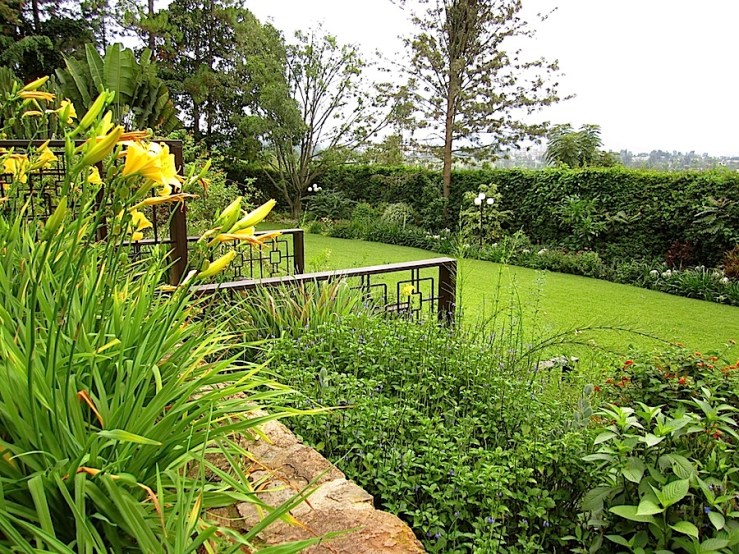 Above: In this section of the middle border are Russelia equisetiformis lutea and an orange Lantana camera (both at the edge), bright blue eranthemum bushes (at the far right), a lemongrass (beside the railing), and. . .
Above: In this section of the middle border are Russelia equisetiformis lutea and an orange Lantana camera (both at the edge), bright blue eranthemum bushes (at the far right), a lemongrass (beside the railing), and. . .
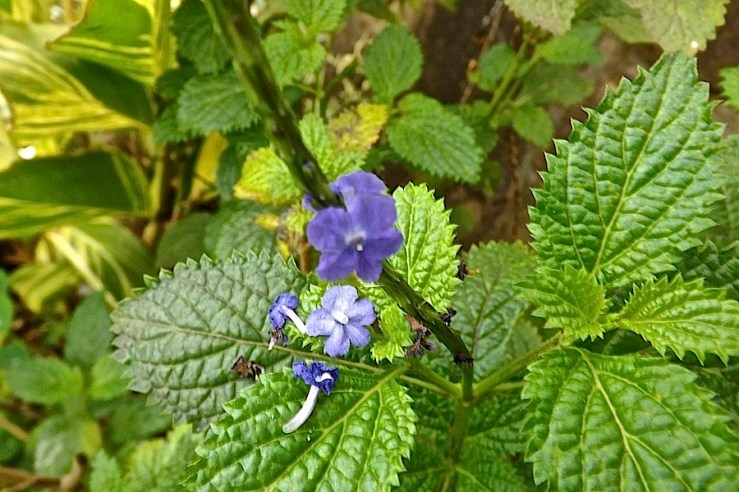 Above: this blue-purple-flowering perennial — possibly a salvia. Does anyone know its name? It’s about 3′ to 4′ tall and almost a weed, but I use it all over the garden for the color and its quick, robust growth.
Above: this blue-purple-flowering perennial — possibly a salvia. Does anyone know its name? It’s about 3′ to 4′ tall and almost a weed, but I use it all over the garden for the color and its quick, robust growth.
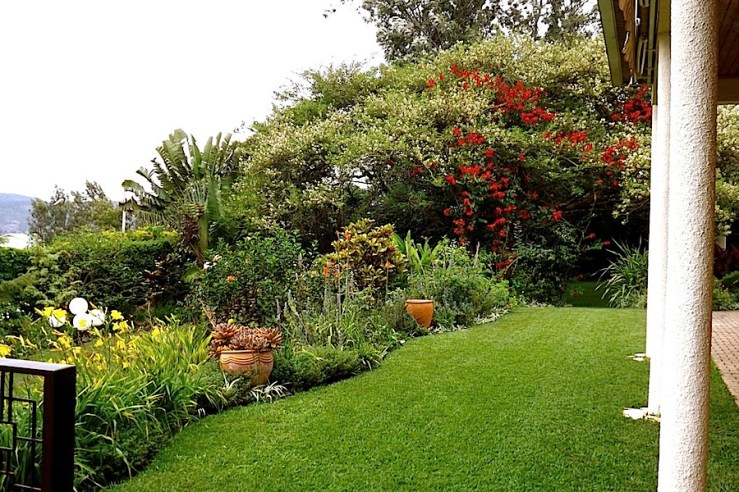 Above: Looking back towards the north, our big acacia tree was blooming last week, looking very impressive with the bright red Mussaenda erythrophylla vine.
Above: Looking back towards the north, our big acacia tree was blooming last week, looking very impressive with the bright red Mussaenda erythrophylla vine.
 Above: Its flowers are small white puffballs.
Above: Its flowers are small white puffballs.
 Above: There’s a tall variegated croton in the center, with more kalanchoe, kniphofia, and variegated groundcover irises along the border. Behind the croton, Heliconia rostrata (lobster claws) are peeking out.
Above: There’s a tall variegated croton in the center, with more kalanchoe, kniphofia, and variegated groundcover irises along the border. Behind the croton, Heliconia rostrata (lobster claws) are peeking out.
Behind the pot is a pink lantana and the stems of a shrub that looks like a privet and has heavily scented white flowers. I limbed it up like a small multi-trunk tree, but some brown birds (they look like small parrots, but they aren’t) keep eating off the leaves. I think I will have to give up on it soon. Behind it are some old scarlet hybrid tea roses and coral pink zonal geraniums. This area is about 50/50 red and pink with a little blue around the edges.
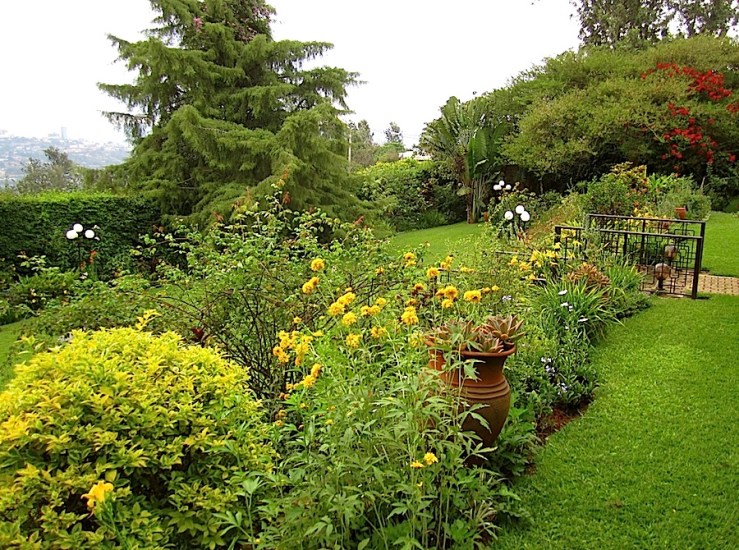 Above: Walking to the south end of the upper lawn and then looking back. There are double Rudbeckia laciniata in the foreground and more graptopelum in the pots. At the left, is a clipped yellow-foliage shrub that I don’t have the name for yet. It’s really a liana, but it is extremely popular in Kigali for shearing into hedges and various balls because it grows so fast. (You just have to clip it back about every month.)
Above: Walking to the south end of the upper lawn and then looking back. There are double Rudbeckia laciniata in the foreground and more graptopelum in the pots. At the left, is a clipped yellow-foliage shrub that I don’t have the name for yet. It’s really a liana, but it is extremely popular in Kigali for shearing into hedges and various balls because it grows so fast. (You just have to clip it back about every month.)
Behind the tall pot, you can also glimpse a few low-pruned light blue cape plumbago and some shasta daisies.
 Above: Turning around and looking back to the south. At the far end of this border are light pink Abutilon x hybridum or Chinese lantern bush. The cactus-like plant is a euphorbia. There’s a huge traveller’s palm behind that.
Above: Turning around and looking back to the south. At the far end of this border are light pink Abutilon x hybridum or Chinese lantern bush. The cactus-like plant is a euphorbia. There’s a huge traveller’s palm behind that.
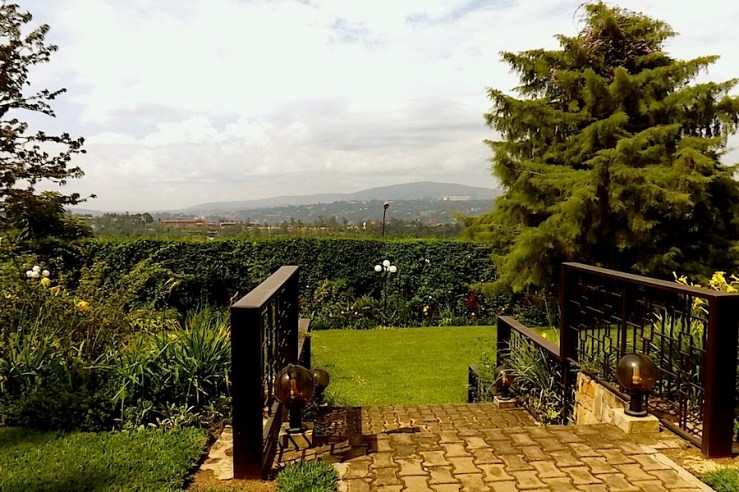 Above: Our view of Mt. Kigali, from the steps in the center of both lawns. Just beyond our hedge, the land dips down into a valley and then up again — so the brick buildings that you see at the top of the hedge are on the other side of the valley, maybe a half mile away, as the crow flies.
Above: Our view of Mt. Kigali, from the steps in the center of both lawns. Just beyond our hedge, the land dips down into a valley and then up again — so the brick buildings that you see at the top of the hedge are on the other side of the valley, maybe a half mile away, as the crow flies.
 Above: Standing at the bottom of the steps, looking at the north side. The orange lantana from the photo above hangs over the lower retaining wall. Below it are rudbeckia (not blooming), yellow daylilies, some calla lilies, and some shasta daisies. Beside the railing is a Brunfelsia latifolia (aka B. australis) or yesterday, today, tomorrow shrub, more russelia with cream blooms, and a vine/shrub that looks like jasmine, but has unscented yellow blooms.
Above: Standing at the bottom of the steps, looking at the north side. The orange lantana from the photo above hangs over the lower retaining wall. Below it are rudbeckia (not blooming), yellow daylilies, some calla lilies, and some shasta daisies. Beside the railing is a Brunfelsia latifolia (aka B. australis) or yesterday, today, tomorrow shrub, more russelia with cream blooms, and a vine/shrub that looks like jasmine, but has unscented yellow blooms.
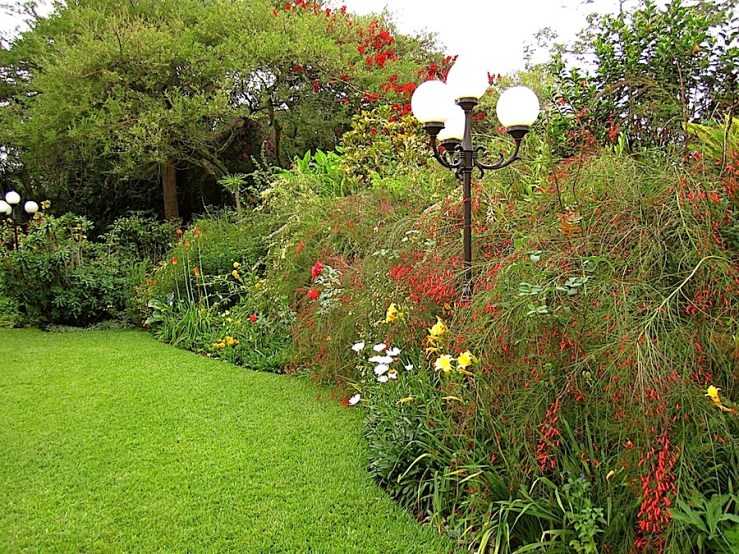 Above: This red and yellow section is going strong at the moment. There are lots of Russelia equisetiformis in red, as well as cream, more double Rudbeckia laciniata, dayllilies, and shasta daisies in this border. At the end are more kniphofia, which I use throughout the garden. I love orange, so I put them in every color-themed section, regarding them as a sort of repeating “neutral.”
Above: This red and yellow section is going strong at the moment. There are lots of Russelia equisetiformis in red, as well as cream, more double Rudbeckia laciniata, dayllilies, and shasta daisies in this border. At the end are more kniphofia, which I use throughout the garden. I love orange, so I put them in every color-themed section, regarding them as a sort of repeating “neutral.”
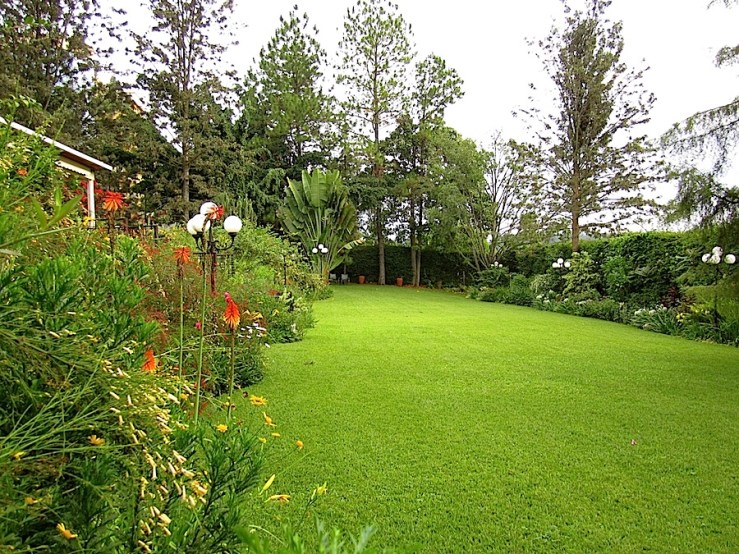 Above: Standing at the north end of the lower lawn, looking to the south. At the far end are two pots setting off a group of pine trees.
Above: Standing at the north end of the lower lawn, looking to the south. At the far end are two pots setting off a group of pine trees.
 Above: Standing back at the bottom of the center steps looking south. In the center on the retaining wall is a huge white-blooming rose that is soon to be pruned. Below it are orange bird of paradise, variegated ginger, lamb’s ear, Verbena bonariensis and some small purple alliums. A little further down are more double rudbeckia, yellow daylilies, Missouri primrose, and dill.
Above: Standing back at the bottom of the center steps looking south. In the center on the retaining wall is a huge white-blooming rose that is soon to be pruned. Below it are orange bird of paradise, variegated ginger, lamb’s ear, Verbena bonariensis and some small purple alliums. A little further down are more double rudbeckia, yellow daylilies, Missouri primrose, and dill.
At the very end is a mix of red and yellow-flowering plants to match the north end of the retaining walls (above), but they are not so well established yet.
 Above: Looking at the lower lawn from the south end. At the left, is a red section, with pink as a second color and blue around the edges. There are red-blooming cannas and cannas with burgundy leaves, red ornamental sage, shrimp plants, and red roses. The pink comes from gerbera daisies and an azalea bush.
Above: Looking at the lower lawn from the south end. At the left, is a red section, with pink as a second color and blue around the edges. There are red-blooming cannas and cannas with burgundy leaves, red ornamental sage, shrimp plants, and red roses. The pink comes from gerbera daisies and an azalea bush.
After it, are sections with light purple, then yellow, then pink flowers predominating — finishing in the center, across from the steps, with yellow flowers and foliage (and beyond that is a section with light orange, light purple, coral pink and a bit of red). But this long, newer border is not yet as colorful as the other side of the lawn.
All night the sound had
come back again,
and again falls
this quiet, persistent rain. . . .— Robert Creeley, from “The Rain“
Our garden on August 31, at the end of the dry season:
And on September 11, after several days of rain:
Much better. After the first rain or two, everything seemed almost sparkly.
Below (click on any of the thumbnails in the gallery) is a little tour of the borders along the upper and lower lawns, taken on September 11 — just before sunset — and yesterday afternoon.
I think this will be my slightly early Garden Bloggers’ Bloom Day and Foliage Follow-Up submission for September. Please go to May Dreams Gardens (Bloom Day on September 15) and Digging (Foliage Follow-Up on September 16) to see what’s happening in other Garden Bloggers’ gardens.